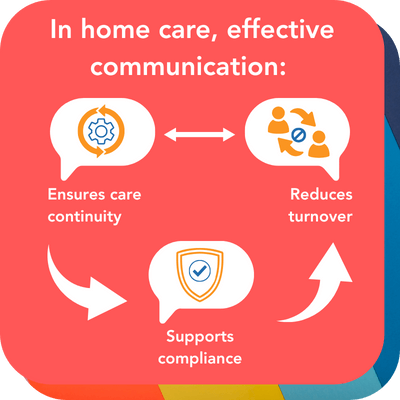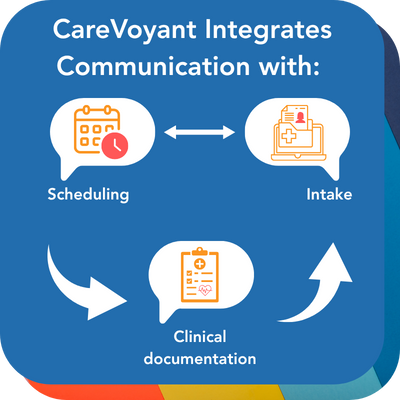Discover tools and strategies to improve communication in home care, enhance care coordination, and boost caregiver and patient satisfaction.
Introduction
In today’s fast-paced home care environment, communication in home care is more critical than ever. Caregivers, nurses, and office staff often work across various locations and shifts, which makes real-time, accurate communication a challenge. When information falls through the cracks, the consequences can be serious: missed visits, medication errors, frustrated families, and burned-out staff.
These issues do not just impact care delivery. They disrupt care coordination, reduce operational efficiency, and erode patient trust. Without the right caregiver communication tools and protocols, even the most dedicated care teams can struggle to stay aligned.
The good news? With the right strategies and home care communication software, agencies can bridge these gaps. Read on to explore proven techniques to streamline communication, enhance team collaboration, and improve outcomes for both patients and staff.
Why Effective Communication Matters in Home Care
In home care, effective communication is more than just exchanging information - it is the foundation of safe, high quality, and compassionate care. Strong communication in home care directly impacts every aspect of service delivery, from daily caregiving tasks to long-term outcomes and satisfaction.
Ensuring continuity of care is one of the most critical benefits. When caregivers, nurses, and office staff can efficiently share updates and access the same information, clients receive consistent and coordinated support, even as personnel rotate.
Seamless care coordination ensures that no detail is lost during handoffs or shift changes.
Accurate, timely updates prevent misunderstandings about medication schedules, care plans, or patient preferences.
Moreover, effective communication improves the caregiver experience. Enhancing staff morale and reducing turnover becomes easier when employees feel informed, supported, and connected to their teams. This also leads to higher patient and family satisfaction, as consistent, transparent interactions build trust and confidence in care providers.
Finally, effective patient-centered communication supports compliance with federal and state regulations. Thorough documentation, informed consent, and coordinated reporting are essential for audits and reimbursement—and are only possible when communication systems are reliable and secure.
In short, improving communication is not just a convenience - it is a strategic necessity for delivering safe, compassionate, and high-quality home care.
Common Communication Challenges in Home Care Settings
Many agencies struggle with communication obstacles that disrupt workflow, hinder collaboration, and compromise care quality. Below are some of the most common challenges care teams face and why addressing them is crucial.
Fragmented Communication Across Shifts
When multiple caregivers rotate through a client’s care, lack of continuity becomes a major issue. Without real-time caregiver communication tools, important updates can be missed, leading to inconsistent care and duplicated tasks.
Inconsistent Documentation and Missed Updates
Outdated or delayed note-taking practices can result in critical information being lost or misinterpreted. This affects care decisions, compliance, and overall coordination-especially when there is no centralized platform for tracking updates.
Lack of Secure Clinical Communication
Many caregivers still rely on unsecured methods like text messages or personal phone calls to communicate. This not only puts sensitive information at risk but also fails to meet HIPAA standards. Reliable, encrypted clinical communication tools are essential to ensure patient privacy and protect the agency from liability.
Language and Literacy Barriers
In diverse communities, communication is often hampered by language differences or varying levels of health literacy. Misunderstandings between staff-or between caregivers and clients- can result in medication errors, missed appointments, or incorrect care instructions.
Technological Limitations and Compatibility Issues
Not all caregivers have access to smartphones or consistent internet connections. Additionally, many home care apps lack compatibility across different devices, making it hard for teams to stay connected in real time.
Solving these challenges with the right communication tools and training can dramatically improve team collaboration and care outcomes.
How Home Care Communication Software Enhances Communication
In today’s dynamic home care environment, maintaining timely and accurate communication between caregivers, clinicians, and administrative staff is more complex than ever.
Fragmented updates, manual scheduling, and disparate documentation systems can lead to missed visits, medication errors, poor care transitions, and staff burnout.
That’s where CareVoyant’s integrated home care communication software plays a transformative role.
Connecting the Entire Care Team
CareVoyant’s all-in-one home care platform is designed to improve communication in home care by connecting every member of the care team—caregivers, nurses, schedulers, billing staff, and coordinators—through a centralized system. By eliminating silos and offering real-time access to critical information, CareVoyant empowers care teams to make faster, more informed decisions that enhance both care delivery and operational efficiency.
Through secure messaging, real-time alerts, and shared dashboards, caregivers in the field can instantly communicate updates, clarify care instructions, and report issues without the delays and risks of phone calls, emails, or paper logs. This enables more effective care coordination and ensures no detail is missed across shifts.
Real-Time Task Management and Communication Features
CareVoyant’s Care Coordination & Communication features provide agencies with task management tools that improve oversight and accountability. Schedulers and supervisors can assign, monitor, and adjust caregiver tasks in real-time. Caregivers receive visit instructions and updates directly on their devices, reducing misunderstandings and missed care activities.
In addition, the software supports internal communication channels that allow real-time, HIPAA-compliant messaging among care teams. This helps replace fragmented communication methods like unsecured text messages or undocumented phone calls - supporting both clinical safety and regulatory compliance.
Integrated Scheduling with Communication Capabilities
Effective scheduling is at the heart of caregiver communication tools, and CareVoyant offers robust scheduling features that are fully integrated with its communication system. As schedules are updated, assigned caregivers are automatically notified of changes, cancellations, or urgent visit requests. With drag-and-drop scheduling, conflict checks, and real-time availability, communication between caregivers and office staff becomes fluid and proactive.
This integration significantly reduces scheduling errors, late arrivals, and gaps in care coverage - all of which are common pain points when agencies rely on disconnected tools.
Enabling Better Clinical Oversight and Documentation
Communication between clinicians and field staff is critical for maintaining care quality. CareVoyant’s platform bridges this gap with shared patient charts, visit history, and real-time clinical documentation tools. Supervisors and nurses can monitor visit notes, review patient status, and communicate changes instantly with caregivers.
This enhances patient-centered communication, enabling more timely interventions and personalized care. Clinical leaders can also use the data to identify gaps, prevent readmissions, and meet quality-of-care benchmarks.
Improving Staff Engagement and Reducing Turnover
CareVoyant’s care team communication tool helps to reduce caregiver frustration and burnout. When caregivers feel connected, supported, and well-informed, they’re more likely to stay engaged and committed to delivering high-quality care. Clear, consistent communication also promotes team trust and transparency—critical factors in staff retention and morale.
CareVoyant care co-ordination and communication features help in higher caregiver satisfaction, improved coordination, and better performance on client satisfaction surveys.
Enhancing Quality of Care and Compliance
CareVoyant care team communication tool leads to better outcomes - fewer missed visits, reduced hospitalizations, and more accurate billing and documentation. Real-time data sharing ensures that agencies can respond quickly to patient needs and document services thoroughly, supporting both quality improvement and compliance.
With integrated tools for billing, EMR, scheduling, and clinical communication, CareVoyant reduces the risk of duplicative documentation and promotes a single source of truth across the care continuum.
Conclusion
Agencies must take a proactive approach by regularly auditing their current communication practices and tools. Are caregivers equipped with real-time messaging? Is documentation shared seamlessly across shifts? Are clinical updates secure and accessible? If the answer is no, it is time to explore smarter, more integrated care coordination tools.
CareVoyant Home Care Software offers an all-in-one platform designed to unify care teams, streamline workflows, and support patient-centered communication. With features like task management, real-time documentation, secure messaging, and integrated scheduling and billing, CareVoyant empowers agencies to deliver better care - faster and more efficiently.
Evaluate your agency’s communication gaps and discover how CareVoyant can help you build a more connected, compliant, and client-focused care environment.
Frequently Asked Questions
-
Communication ensures continuity of care, improves patient outcomes, supports regulatory compliance, and boosts caregiver satisfaction in home care environments.
-
Common challenges include fragmented updates, shift handoff errors, insecure messaging, documentation delays, and tech limitations among staff.
-
It can lead to missed visits, medication errors, duplicated efforts, frustrated caregivers, and decreased patient satisfaction.
-
The most effective strategy is using centralized home care communication software that offers real-time updates, secure messaging, and integrated scheduling.
-
CareVoyant connects care teams with secure messaging, task management, clinical documentation, and scheduling tools to streamline coordination.
-
Yes. HIPAA-compliant messaging protects patient data and reduces liability while enabling real-time clinical updates and coordination.
-
It ensures caregivers receive timely visit updates, reduces errors, and helps schedulers coordinate care more efficiently through automation.
-
Look for secure chat, real-time alerts, shared patient records, task tracking, integrated scheduling, and mobile accessibility.
-
Absolutely. Tools that keep caregivers informed and connected improve job satisfaction, reduce burnout, and help retain qualified staff.
-
Agencies should audit for gaps in real-time messaging, documentation sharing, clinical oversight, and HIPAA compliance to identify improvement areas.
About CareVoyant
CareVoyant is a leading provider of cloud-based integrated enterprise-scale home health care software that can support all home-based services under ONE Software, ONE Patient, and ONE Employee, making it a Single System of Record. We support all home based services, including Home Care, Private Duty Nursing, Private Duty Non-Medical, Home and Community Based Services (HCBS), Home Health, Pediatric Home Care, and Outpatient Therapy at Home.
CareVoyant functions – Intake, Authorization Management, Scheduling, Clinical with Mobile options, eMAR/eTAR, Electronic Visit Verification (EVV), Billing/AR, Secure Messaging, Notification, Reporting, and Dashboards – streamline workflow, meet regulatory requirements, improve quality of care, optimize reimbursement, improve operational efficiency and agency bottom line.
For more information, please visit CareVoyant.com or call us at 1-888-463-6797.
Request for Information
To learn more about CareVoyant Software and how we improve the operational efficiency of Home Healthcare Agencies, contact us:





